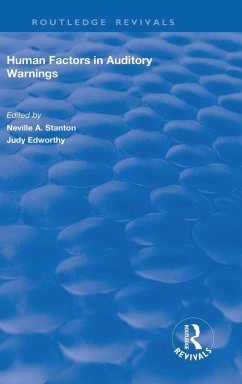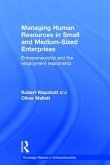Human Factors in Auditory Warnings
Herausgeber: Edworthy, Judy; Stanton, Neville A.
Human Factors in Auditory Warnings
Herausgeber: Edworthy, Judy; Stanton, Neville A.
- Gebundenes Buch
- Merkliste
- Auf die Merkliste
- Bewerten Bewerten
- Teilen
- Produkt teilen
- Produkterinnerung
- Produkterinnerung
First published in 1999, this book represents the position of contemporary auditory warnings research and development in a single unique volume.
Andere Kunden interessierten sich auch für
![Cultural Factors and Performance in 21st Century Businesses Cultural Factors and Performance in 21st Century Businesses]() Cultural Factors and Performance in 21st Century Businesses194,99 €
Cultural Factors and Performance in 21st Century Businesses194,99 €![Economic Factors of the Development of Agricultural Markets and Rural Areas Economic Factors of the Development of Agricultural Markets and Rural Areas]() Economic Factors of the Development of Agricultural Markets and Rural Areas92,99 €
Economic Factors of the Development of Agricultural Markets and Rural Areas92,99 €![Driving Factors for Venture Creation and Success in Agricultural Entrepreneurship Driving Factors for Venture Creation and Success in Agricultural Entrepreneurship]() Mohd Yasir ArafatDriving Factors for Venture Creation and Success in Agricultural Entrepreneurship215,99 €
Mohd Yasir ArafatDriving Factors for Venture Creation and Success in Agricultural Entrepreneurship215,99 €![Identification of Factors related to Human Development Index Identification of Factors related to Human Development Index]() Muhammad Kashan JavedIdentification of Factors related to Human Development Index30,99 €
Muhammad Kashan JavedIdentification of Factors related to Human Development Index30,99 €![Factors affecting the acquisition of motor skills in bodybuilding Factors affecting the acquisition of motor skills in bodybuilding]() Fernanda Santos OliveiraFactors affecting the acquisition of motor skills in bodybuilding27,99 €
Fernanda Santos OliveiraFactors affecting the acquisition of motor skills in bodybuilding27,99 €![Factors Affecting Invention and Innovations in Science and Technology Factors Affecting Invention and Innovations in Science and Technology]() Jin Xiao YinFactors Affecting Invention and Innovations in Science and Technology28,99 €
Jin Xiao YinFactors Affecting Invention and Innovations in Science and Technology28,99 €![Managing Human Resources in Small and Medium-Sized Enterprises Managing Human Resources in Small and Medium-Sized Enterprises]() Robert WapshottManaging Human Resources in Small and Medium-Sized Enterprises167,99 €
Robert WapshottManaging Human Resources in Small and Medium-Sized Enterprises167,99 €-
-
-
First published in 1999, this book represents the position of contemporary auditory warnings research and development in a single unique volume.
Produktdetails
- Produktdetails
- Verlag: Routledge
- Seitenzahl: 394
- Erscheinungstermin: 10. August 2018
- Englisch
- Abmessung: 240mm x 161mm x 26mm
- Gewicht: 754g
- ISBN-13: 9781138316287
- ISBN-10: 1138316288
- Artikelnr.: 57052660
- Herstellerkennzeichnung
- Libri GmbH
- Europaallee 1
- 36244 Bad Hersfeld
- gpsr@libri.de
- Verlag: Routledge
- Seitenzahl: 394
- Erscheinungstermin: 10. August 2018
- Englisch
- Abmessung: 240mm x 161mm x 26mm
- Gewicht: 754g
- ISBN-13: 9781138316287
- ISBN-10: 1138316288
- Artikelnr.: 57052660
- Herstellerkennzeichnung
- Libri GmbH
- Europaallee 1
- 36244 Bad Hersfeld
- gpsr@libri.de
Neville Stanton is Professor at the Department of Design, Brunel University, Uxbridge, UK. Previously, he was a Reader in Engineering Psychology at the University of Southampton, and Visiting Fellow at the College of Human Ecology at Cornell University, New York, USA He is also a Human Factors Consultant, and is editor of Human Factors in Alarm Design, 1994; Human Factors in Nuclear Safety, 1996; and Human Factors in Consumer Products, 1998, all with Taylor & Francis. Judy Edworthy is a Reader in Human Factors in the Psychology Department at the University of Plymouth. She is the author of many significant articles on auditory warnings and joint author with Austin Adams of Warning Design: A Research Prospective, 1996, Taylor & Francis.
1. Auditory Warning and Displays: An Overview. Neville A. Stanton and Judy
Edworthy. 2. Localisable Alarms. Deborah J. Withington. 3. Audibility of
Reverse Alarms under Hearing Protectors and its Prediction for Normal and
Hearing-Impaired Listeners. Gary S. Robinson, John G. Casali. 4. Extending
the Domain of Auditory Warning Sounds: Creative Use of High Frequencies and
Temporal Asymmetry. R.D Patterson, A.J. Datta. 5. The Interpretation of
Natural Sound in the Cockpit. James A.Ballas. 6. Auditory Warning
Affordance. Neville A. Stanton, Judy Edworthy. 7. The Perceived Urgency and
Detection Time of Multitone Auditory Signals. Ellen C. Haas, Judy Edworthy
. 8. A Psychophysiological Evaluation of The Perceived of the Perceived
Urgency of Auditory Warning Signals. Jennifer L. Burt, Debbie S.
Bartolome-Rull, Daniel W. Burdette, J. Raymond Comstock. 9. Investigations
of Alarm Mistrust under Conditions of Varying Alarm and Outgoing Task
Criticality. James P. Bliss. 10. Using Redundancy in the Design of
Time-Critical Warnings: A Theory-Driven Approach. Stephen J. Selcon. 11.
Different Effects f Auditory Feedback in Man-Machine Interfaces. Matthias
Rayer Berg. 12. Speech-Based Alarm Displays. Neville A. Stanton , C. Baber
. 13. Designing Aircraft Warning System: A Case Study. J.M. Noyes, A.F
Cresswell Starr, J.A. Rankin. 14. The Design and Validation of Attensons
for a High Workload Environment. Elizabeth Hellier , Judy Edworthy. 15.
Observational Studies of Auditory Warnings on the Intensive Care Unit.
Christina Meredith, Judy Edworthy, David Rose. 16. Auditory Alarms in
Intensive Care. John Welch. 17. Key Topics in Auditory Warnings. Neville A.
Stanton, Judy Edworthy.
Edworthy. 2. Localisable Alarms. Deborah J. Withington. 3. Audibility of
Reverse Alarms under Hearing Protectors and its Prediction for Normal and
Hearing-Impaired Listeners. Gary S. Robinson, John G. Casali. 4. Extending
the Domain of Auditory Warning Sounds: Creative Use of High Frequencies and
Temporal Asymmetry. R.D Patterson, A.J. Datta. 5. The Interpretation of
Natural Sound in the Cockpit. James A.Ballas. 6. Auditory Warning
Affordance. Neville A. Stanton, Judy Edworthy. 7. The Perceived Urgency and
Detection Time of Multitone Auditory Signals. Ellen C. Haas, Judy Edworthy
. 8. A Psychophysiological Evaluation of The Perceived of the Perceived
Urgency of Auditory Warning Signals. Jennifer L. Burt, Debbie S.
Bartolome-Rull, Daniel W. Burdette, J. Raymond Comstock. 9. Investigations
of Alarm Mistrust under Conditions of Varying Alarm and Outgoing Task
Criticality. James P. Bliss. 10. Using Redundancy in the Design of
Time-Critical Warnings: A Theory-Driven Approach. Stephen J. Selcon. 11.
Different Effects f Auditory Feedback in Man-Machine Interfaces. Matthias
Rayer Berg. 12. Speech-Based Alarm Displays. Neville A. Stanton , C. Baber
. 13. Designing Aircraft Warning System: A Case Study. J.M. Noyes, A.F
Cresswell Starr, J.A. Rankin. 14. The Design and Validation of Attensons
for a High Workload Environment. Elizabeth Hellier , Judy Edworthy. 15.
Observational Studies of Auditory Warnings on the Intensive Care Unit.
Christina Meredith, Judy Edworthy, David Rose. 16. Auditory Alarms in
Intensive Care. John Welch. 17. Key Topics in Auditory Warnings. Neville A.
Stanton, Judy Edworthy.
1. Auditory Warning and Displays: An Overview. Neville A. Stanton and Judy
Edworthy. 2. Localisable Alarms. Deborah J. Withington. 3. Audibility of
Reverse Alarms under Hearing Protectors and its Prediction for Normal and
Hearing-Impaired Listeners. Gary S. Robinson, John G. Casali. 4. Extending
the Domain of Auditory Warning Sounds: Creative Use of High Frequencies and
Temporal Asymmetry. R.D Patterson, A.J. Datta. 5. The Interpretation of
Natural Sound in the Cockpit. James A.Ballas. 6. Auditory Warning
Affordance. Neville A. Stanton, Judy Edworthy. 7. The Perceived Urgency and
Detection Time of Multitone Auditory Signals. Ellen C. Haas, Judy Edworthy
. 8. A Psychophysiological Evaluation of The Perceived of the Perceived
Urgency of Auditory Warning Signals. Jennifer L. Burt, Debbie S.
Bartolome-Rull, Daniel W. Burdette, J. Raymond Comstock. 9. Investigations
of Alarm Mistrust under Conditions of Varying Alarm and Outgoing Task
Criticality. James P. Bliss. 10. Using Redundancy in the Design of
Time-Critical Warnings: A Theory-Driven Approach. Stephen J. Selcon. 11.
Different Effects f Auditory Feedback in Man-Machine Interfaces. Matthias
Rayer Berg. 12. Speech-Based Alarm Displays. Neville A. Stanton , C. Baber
. 13. Designing Aircraft Warning System: A Case Study. J.M. Noyes, A.F
Cresswell Starr, J.A. Rankin. 14. The Design and Validation of Attensons
for a High Workload Environment. Elizabeth Hellier , Judy Edworthy. 15.
Observational Studies of Auditory Warnings on the Intensive Care Unit.
Christina Meredith, Judy Edworthy, David Rose. 16. Auditory Alarms in
Intensive Care. John Welch. 17. Key Topics in Auditory Warnings. Neville A.
Stanton, Judy Edworthy.
Edworthy. 2. Localisable Alarms. Deborah J. Withington. 3. Audibility of
Reverse Alarms under Hearing Protectors and its Prediction for Normal and
Hearing-Impaired Listeners. Gary S. Robinson, John G. Casali. 4. Extending
the Domain of Auditory Warning Sounds: Creative Use of High Frequencies and
Temporal Asymmetry. R.D Patterson, A.J. Datta. 5. The Interpretation of
Natural Sound in the Cockpit. James A.Ballas. 6. Auditory Warning
Affordance. Neville A. Stanton, Judy Edworthy. 7. The Perceived Urgency and
Detection Time of Multitone Auditory Signals. Ellen C. Haas, Judy Edworthy
. 8. A Psychophysiological Evaluation of The Perceived of the Perceived
Urgency of Auditory Warning Signals. Jennifer L. Burt, Debbie S.
Bartolome-Rull, Daniel W. Burdette, J. Raymond Comstock. 9. Investigations
of Alarm Mistrust under Conditions of Varying Alarm and Outgoing Task
Criticality. James P. Bliss. 10. Using Redundancy in the Design of
Time-Critical Warnings: A Theory-Driven Approach. Stephen J. Selcon. 11.
Different Effects f Auditory Feedback in Man-Machine Interfaces. Matthias
Rayer Berg. 12. Speech-Based Alarm Displays. Neville A. Stanton , C. Baber
. 13. Designing Aircraft Warning System: A Case Study. J.M. Noyes, A.F
Cresswell Starr, J.A. Rankin. 14. The Design and Validation of Attensons
for a High Workload Environment. Elizabeth Hellier , Judy Edworthy. 15.
Observational Studies of Auditory Warnings on the Intensive Care Unit.
Christina Meredith, Judy Edworthy, David Rose. 16. Auditory Alarms in
Intensive Care. John Welch. 17. Key Topics in Auditory Warnings. Neville A.
Stanton, Judy Edworthy.








